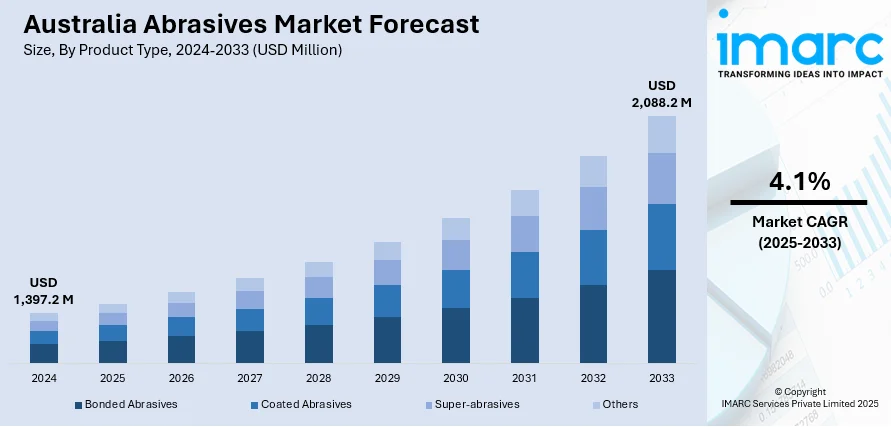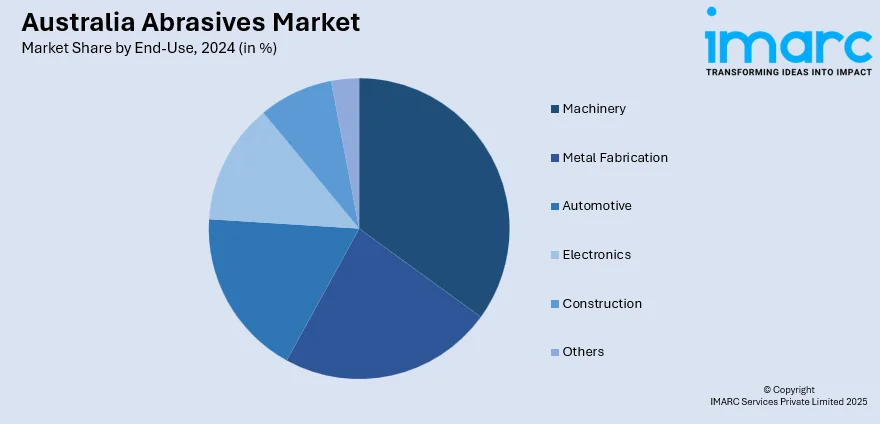
Australia Abrasives Market Size, Share, Trends and Forecast by Product Type, Material Type, End-Use, and Region, 2025-2033
Australia Abrasives Market Size and Growth:
The Australia abrasives market size reached USD 1,397.2 Million in 2024. Looking forward, IMARC Group expects the market to reach USD 2,088.2 Million by 2033, exhibiting a growth rate (CAGR) of 4.1% during 2025-2033. The market is experiencing steady growth, driven by expanding manufacturing, construction, and mining sectors. Technological advancements and a shift towards sustainable practices are further influencing market dynamics, with increased demand for high-performance and eco-friendly abrasive products.
|
Report Attribute
|
Key Statistics
|
|---|---|
|
Base Year
|
2024
|
|
Forecast Years
|
2025-2033
|
|
Historical Years
|
2019-2024
|
| Market Size in 2024 | USD 1,397.2 Million |
| Market Forecast in 2033 | USD 2,088.2 Million |
| Market Growth Rate 2025-2033 | 4.1% |
Australia Abrasives Market Trends:
Manufacturing and Construction Demand
Australia's strong manufacturing and construction industries predominantly drive the Australian market. The manufacturing process depends heavily on abrasives in terms of grinding, polishing, and cutting, while the automotive, aerospace, and metal fabrication industries utilize them. The construction industry relies on abrasives for concrete polishing, material cutting, and surface preparation. Increased infrastructure development projects and residential developments have driven increased consumption of abrasive materials. Additionally, the expansion of the automobile sector, as reflected in the production and sales of automobiles, has also boosted the demand for abrasives used in the manufacture and maintenance of cars. The development of the mining sector also contributes to the market since abrasives play a key role in equipment maintenance and processing of minerals. The constant progress of all these industries guarantees the continuous demand for various forms of abrasive products like bonded, coated, and super abrasives. The future course of the market is heavily correlated with these industries' performance since their progress also dictates abrasive use directly. With increased technological developments in these industries, demand will continue to escalate for more efficient and precision-based abrasives and, hence, shape the course of the future market.

To get more information on this market, Request Sample
Technological Advancements and Sustainability
Technological advancement and environmental factors are transforming the Australian abrasives market. Companies are putting money into research and development to produce abrasives that are suited to the changing demands of contemporary industries. The development of high-performance products, including diamond-coated abrasives, fills the need for abrasives with enhanced durability and efficiency. Such developments are highly useful in industries that demand precision, such as electronics and aerospace. At the same time, there is an increased focus on sustainability, and this has resulted in the creation of green abrasive products. Firms are experimenting with natural, biodegradable materials, including water-based abrasives, to lower environmental footprints. Both consumer demand for cleaner products and regulatory forces promote this change. The application of digital technologies, including data analytics and automation, in manufacturing, helps improve the quality of products and the efficiency of operations. These environmental and technological trends are not only addressing today's market needs but also introducing new opportunities for innovation and development. As companies continue to focus on performance and sustainability, the abrasives market will be in a position to develop, providing products that are consistent with these ideals.
Australia Abrasives Market Segmentation:
IMARC Group provides an analysis of the key trends in each segment of the market, along with forecasts at the country level for 2025-2033. Our report has categorized the market based on product type, material type, and end-use.
Product Type Insights:
- Bonded Abrasives
- Coated Abrasives
- Super-abrasives
- Others
The report has provided a detailed breakup and analysis of the market based on the product type. This includes bonded abrasives, coated abrasives, super-abrasives, and others.
Material Type Insights:
- Natural Abrasives
- Synthetic Abrasives
A detailed breakup and analysis of the market based on the material type have also been provided in the report. This includes natural abrasives and synthetic abrasives.
End-Use Insights:

- Machinery
- Metal Fabrication
- Automotive
- Electronics
- Construction
- Others
A detailed breakup and analysis of the market based on the end-use have also been provided in the report. This includes machinery, metal fabrication, automotive, electronics, construction, and others.
Regional Insights:
- Australia Capital Territory & New South Wales
- Victoria & Tasmania
- Queensland
- Northern Territory & Southern Australia
- Western Australia
The report has also provided a comprehensive analysis of all the major regional markets, which include Australia Capital Territory & New South Wales, Victoria & Tasmania, Queensland, Northern Territory & Southern Australia, and Western Australia.
Competitive Landscape:
The market research report has also provided a comprehensive analysis of the competitive landscape. Competitive analysis such as market structure, key player positioning, top winning strategies, competitive dashboard, and company evaluation quadrant has been covered in the report. Also, detailed profiles of all major companies have been provided.
Australia Abrasives Market News:
- October 2024: Autolac launched SmartLine ceramic abrasives in Australia, introducing high-performance Velcro-backed discs and multi-hole rolls. Featuring advanced ceramic grain, the products enhanced sanding efficiency, durability, and cost-effectiveness, boosting productivity in automotive and industrial sectors and contributing to Australia's growing abrasives market development.
- March 2024: GMA Garnet Group launched ExtremeBlast in Australia and New Zealand, expanding its abrasive product line. Designed for heavy coating removal and surface profiling, the innovation strengthened GMA’s market presence, boosted industrial efficiency, and advanced the abrasives sector’s capabilities across diverse applications.
Australia Abrasives Market Report Coverage:
| Report Features | Details |
|---|---|
| Base Year of the Analysis | 2024 |
| Historical Period | 2019-2024 |
| Forecast Period | 2025-2033 |
| Units | Million USD |
| Scope of the Report |
Exploration of Historical Trends and Market Outlook, Industry Catalysts and Challenges, Segment-Wise Historical and Future Market Assessment:
|
| Product Types Covered | Bonded Abrasives, Coated Abrasives, Super-abrasives, Others |
| Material Types Covered | Natural Abrasives, Synthetic Abrasives |
| End-Uses Covered | Machinery, Metal Fabrication, Automotive, Electronics, Construction, Others |
| Regions Covered | Australia Capital Territory & New South Wales, Victoria & Tasmania, Queensland, Northern Territory & Southern Australia, Western Australia |
| Customization Scope | 10% Free Customization |
| Post-Sale Analyst Support | 10-12 Weeks |
| Delivery Format | PDF and Excel through Email (We can also provide the editable version of the report in PPT/Word format on special request) |
Key Questions Answered in This Report:
- How has the Australia abrasives market performed so far and how will it perform in the coming years?
- What is the breakup of the Australia abrasives market on the basis of product type?
- What is the breakup of the Australia abrasives market on the basis of material type?
- What is the breakup of the Australia abrasives market on the basis of end use?
- What are the various stages in the value chain of the Australia abrasives market?
- What are the key driving factors and challenges in the Australia abrasives?
- What is the structure of the Australia abrasives market and who are the key players?
- What is the degree of competition in the Australia abrasives market?
Key Benefits for Stakeholders:
- IMARC’s industry report offers a comprehensive quantitative analysis of various market segments, historical and current market trends, market forecasts, and dynamics of the Australia abrasives market from 2019-2033.
- The research report provides the latest information on the market drivers, challenges, and opportunities in the Australia abrasives market.
- Porter's five forces analysis assist stakeholders in assessing the impact of new entrants, competitive rivalry, supplier power, buyer power, and the threat of substitution. It helps stakeholders to analyze the level of competition within the Australia abrasives market industry and its attractiveness.
- Competitive landscape allows stakeholders to understand their competitive environment and provides an insight into the current positions of key players in the market.
Need more help?
- Speak to our experienced analysts for insights on the current market scenarios.
- Include additional segments and countries to customize the report as per your requirement.
- Gain an unparalleled competitive advantage in your domain by understanding how to utilize the report and positively impacting your operations and revenue.
- For further assistance, please connect with our analysts.
 Request Customization
Request Customization
 Speak to an Analyst
Speak to an Analyst
 Request Brochure
Request Brochure
 Inquire Before Buying
Inquire Before Buying




.webp)




.webp)












